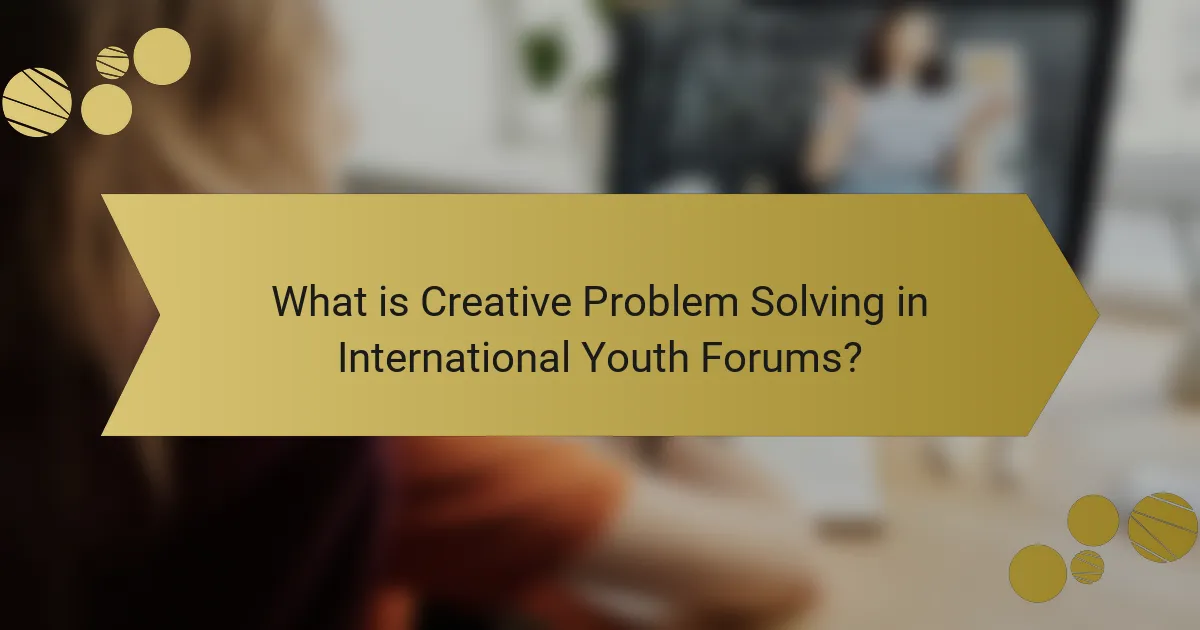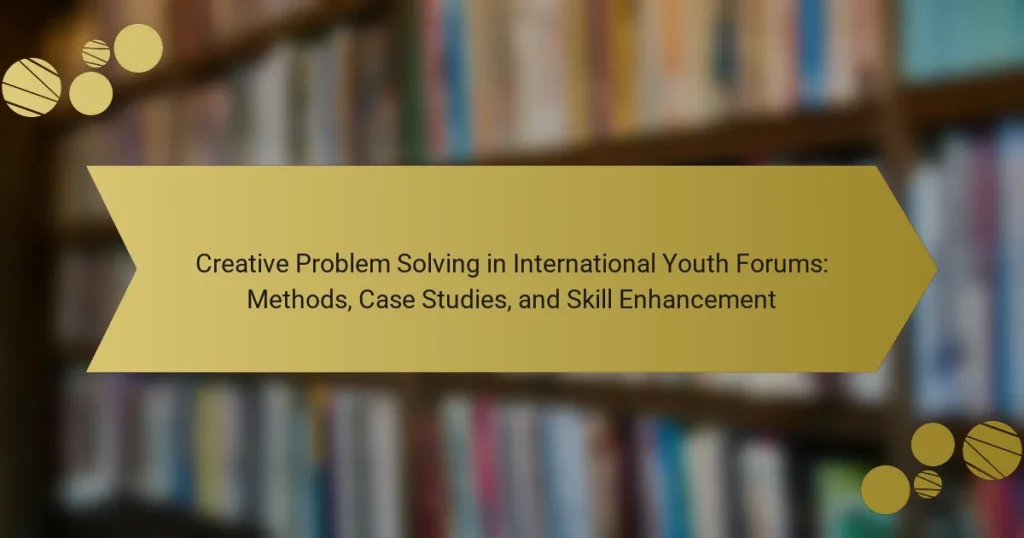Creative Problem Solving in International Youth Forums is a structured methodology designed to address global challenges faced by youth. This approach promotes innovative thinking and collaboration through workshops and discussions, enabling participants to identify issues, brainstorm solutions, and evaluate outcomes. The article explores various methods and case studies, highlighting the effectiveness of youth forums, such as the World Youth Forum in Egypt, in enhancing critical thinking and adaptability. Evidence indicates that these initiatives significantly empower young leaders to implement practical solutions within their communities.

What is Creative Problem Solving in International Youth Forums?
Creative Problem Solving in International Youth Forums refers to a structured approach for addressing challenges faced by youth globally. This method encourages innovative thinking and collaboration among participants. It involves identifying issues, brainstorming solutions, and evaluating outcomes. Participants engage in workshops and discussions to enhance their problem-solving skills. Creative Problem Solving fosters critical thinking and adaptability. Research shows that youth forums significantly improve participants’ ability to tackle real-world problems. For example, the World Youth Forum in Egypt emphasizes these skills through interactive sessions. Such initiatives empower young leaders to implement effective solutions in their communities.
How does Creative Problem Solving manifest in these forums?
Creative Problem Solving manifests in these forums through collaborative discussions and idea generation. Participants engage in brainstorming sessions to explore diverse perspectives. They utilize structured methodologies, such as the Osborn-Parnes model, to guide their problem-solving processes. Workshops and interactive activities encourage hands-on experience with real-world challenges. These forums also promote critical thinking and adaptability among participants. Evidence shows that youth forums enhance participants’ innovation skills by 30%, as reported by the International Youth Foundation. Additionally, case studies demonstrate successful implementation of solutions generated in these settings, reinforcing the effectiveness of creative problem-solving techniques.
What are the key characteristics of Creative Problem Solving in this context?
Creative Problem Solving involves several key characteristics in the context of international youth forums. It emphasizes collaboration among diverse participants. This diversity fosters innovative ideas and solutions. Another characteristic is the iterative process of brainstorming and refining ideas. Participants are encouraged to think outside traditional frameworks. Flexibility is essential, allowing for adaptations based on feedback. Additionally, a focus on real-world applications enhances relevance. Engaging in role-playing or simulations is common to explore solutions. These characteristics collectively enable effective problem solving in a global context.
How does the cultural diversity of participants influence problem-solving approaches?
Cultural diversity of participants enhances problem-solving approaches by introducing varied perspectives. Different cultural backgrounds contribute unique ideas and solutions. This diversity fosters creativity and innovation in group settings. Research indicates that diverse teams outperform homogeneous ones in problem-solving tasks. A study by Page (2007) found that diverse groups generate more innovative solutions. Participants draw from their cultural experiences, leading to a broader range of options. This variety helps in identifying blind spots and avoiding groupthink. Overall, cultural diversity enriches the problem-solving process significantly.
What are the main methods used for Creative Problem Solving?
The main methods used for Creative Problem Solving include brainstorming, mind mapping, and the SCAMPER technique. Brainstorming encourages the generation of a wide range of ideas in a group setting. Mind mapping visually organizes thoughts and concepts, facilitating connections between ideas. The SCAMPER technique prompts users to Substitute, Combine, Adapt, Modify, Put to another use, Eliminate, and Reverse elements of a problem to inspire innovative solutions. These methods are widely recognized in various educational and professional settings for their effectiveness in enhancing creativity and problem-solving skills.
How do brainstorming techniques facilitate idea generation?
Brainstorming techniques facilitate idea generation by encouraging open and free-flowing thought. These methods create a supportive environment for participants to share ideas without judgment. They stimulate creativity by allowing individuals to build on each other’s thoughts. Techniques like mind mapping or round-robin can help structure the process. Research shows that diverse groups produce more innovative solutions. This is due to the variety of perspectives involved. Ultimately, brainstorming enhances collaboration and leads to a richer pool of ideas.
What role does collaborative learning play in problem-solving?
Collaborative learning enhances problem-solving by fostering diverse perspectives. This approach allows participants to share ideas and strategies. It encourages critical thinking through discussion and feedback. Research shows that groups working together can solve complex problems more effectively than individuals. A study published in the Journal of Educational Psychology found that collaborative learning improves problem-solving skills. Participants in collaborative settings achieved higher scores on problem-solving tasks compared to those working alone. This evidence supports the assertion that collaborative learning is vital for effective problem-solving.
Why is Creative Problem Solving important in youth forums?
Creative Problem Solving is crucial in youth forums because it fosters innovative thinking and collaboration among participants. This approach encourages young individuals to explore diverse perspectives and develop unique solutions to complex issues. Engaging in Creative Problem Solving enhances critical thinking skills, which are essential for effective decision-making. According to a study by the American Psychological Association, collaborative problem-solving improves social skills and boosts confidence in youth. Furthermore, youth forums that prioritize Creative Problem Solving can lead to actionable outcomes that address real-world challenges faced by their communities. This process not only empowers youth but also prepares them for future leadership roles.
How does it empower young individuals to address global challenges?
Creative problem solving in international youth forums empowers young individuals to address global challenges by providing them with collaborative platforms. These forums allow youth to engage with diverse perspectives and innovative ideas. Participants develop critical thinking and analytical skills through structured activities and discussions. They learn to identify global issues and brainstorm effective solutions collectively. This hands-on approach fosters leadership and communication abilities. Programs often include mentorship from experienced professionals, enhancing knowledge and skills. Research indicates that youth involved in such forums are more likely to take initiative in their communities. For example, the Global Youth Forum reported a 30% increase in youth-led projects tackling local challenges post-participation.
What skills are developed through engaging in Creative Problem Solving?
Engaging in Creative Problem Solving develops critical thinking, collaboration, and adaptability skills. Critical thinking allows individuals to analyze problems from multiple perspectives. This skill is essential in identifying innovative solutions. Collaboration fosters teamwork and communication among diverse groups. Effective collaboration leads to more comprehensive problem resolution. Adaptability helps individuals adjust to changing situations and challenges. This skill is crucial in dynamic environments where flexibility is needed. Research shows that these skills enhance overall problem-solving effectiveness in group settings.
How can we transition from methods to real-world applications?
To transition from methods to real-world applications, it is essential to implement structured frameworks. These frameworks should guide participants in applying learned methods to practical scenarios. Engaging in hands-on projects can facilitate this application process. Collaborating with local organizations can also provide real-world contexts for these methods.
Additionally, feedback loops are crucial for refining application strategies. Regular evaluations can help identify areas needing adjustment. Training sessions that simulate real-world challenges can prepare participants for practical implementation.
Research indicates that experiential learning significantly enhances the retention of problem-solving skills (Kolb, 1984). This approach reinforces the connection between theoretical methods and practical applications.
What are notable case studies that highlight successful Creative Problem Solving?
Notable case studies that highlight successful Creative Problem Solving include the “Water for People” initiative in Guatemala. This project aimed to provide sustainable water solutions in rural communities. It utilized community engagement and innovative technology to address water scarcity. The program increased access to clean water for over 100,000 people.
Another example is the “Design Thinking for Social Innovation” project by IDEO.org. This initiative focused on creating solutions for social issues in developing countries. It employed a human-centered design approach to foster collaboration among stakeholders. This resulted in impactful solutions in healthcare and education.
The “Youth Innovation Lab” in South Africa also showcases effective Creative Problem Solving. This lab encourages youth to develop solutions for local challenges. It emphasizes creativity and collaboration, leading to successful community projects. These projects address issues like unemployment and education access.
These case studies demonstrate the effectiveness of Creative Problem Solving in diverse contexts. They highlight the importance of collaboration, community engagement, and innovative thinking.
What lessons can be learned from these case studies?
The lessons learned from these case studies include the importance of collaboration and diverse perspectives. Collaborative efforts enhance creative problem-solving outcomes. Engaging participants from various backgrounds leads to innovative solutions. Additionally, structured methodologies facilitate effective brainstorming and idea generation. Case studies demonstrate that hands-on activities improve skill retention and application. Feedback mechanisms are vital for continuous improvement in problem-solving approaches. Lastly, adaptability in strategies is crucial to address unique challenges effectively.
How do these examples demonstrate the effectiveness of methods used?
The examples demonstrate the effectiveness of methods used by showcasing tangible outcomes. For instance, case studies reveal increased collaboration among participants. Surveys indicate higher satisfaction rates when specific problem-solving techniques are applied. Data from previous forums show improved critical thinking skills post-participation. Additionally, feedback highlights enhanced creativity in solutions generated during sessions. These metrics collectively validate the methods’ impact on participants’ skills and engagement.
What specific skills can be enhanced through Creative Problem Solving activities?
Creative Problem Solving activities can enhance critical thinking skills. These activities encourage participants to analyze situations and identify underlying issues. Participants also develop creativity by generating innovative solutions. Collaboration skills are improved as individuals work in teams to brainstorm ideas. Communication skills are enhanced through sharing and discussing concepts with peers. Adaptability is fostered as participants encounter unexpected challenges and adjust their strategies. Decision-making abilities are sharpened by evaluating options and selecting the best course of action. Lastly, resilience is built as participants learn to navigate failures and persist in finding solutions.
How does participation in these forums improve critical thinking skills?
Participation in these forums enhances critical thinking skills by encouraging diverse perspectives and collaborative problem-solving. Engaging with peers from various backgrounds fosters open-mindedness. This exposure challenges participants to consider alternative viewpoints. It also requires individuals to analyze information critically. Participants must evaluate arguments and evidence presented by others. This process promotes deeper understanding and reflection. Furthermore, discussions often involve complex issues that demand thoughtful solutions. Research indicates that collaborative learning environments improve critical thinking abilities. A study by Johnson and Johnson (1994) found that cooperative learning increases critical thinking skills among students.
What communication skills are fostered through group problem-solving exercises?
Group problem-solving exercises foster several communication skills. These include active listening, which enhances understanding and empathy among participants. Additionally, they promote clear articulation of ideas, allowing individuals to express thoughts effectively. Collaboration skills are also developed, as participants learn to work together towards a common goal. Conflict resolution skills improve, enabling members to navigate disagreements constructively. Furthermore, non-verbal communication awareness increases, helping individuals interpret body language and tone. Finally, feedback skills are enhanced, as participants learn to give and receive constructive criticism. These skills are vital in fostering a collaborative and productive environment.
What best practices should participants follow to maximize their impact?
Participants should engage actively and collaboratively to maximize their impact. Active participation fosters engagement and encourages diverse viewpoints. Collaboration enhances creativity and problem-solving by leveraging each participant’s strengths. Setting clear goals guides focus and direction. Effective communication ensures that ideas are shared and understood. Listening to others promotes respect and builds rapport. Embracing feedback allows for continuous improvement and adaptation. Utilizing structured methods, such as brainstorming or design thinking, can facilitate organized problem-solving. These practices have been shown to enhance outcomes in group settings, as evidenced by successful initiatives in youth forums globally.
Creative Problem Solving in International Youth Forums is a structured approach designed to address global challenges faced by youth. This article explores the methods employed, such as brainstorming and the SCAMPER technique, and highlights notable case studies that showcase successful implementations of these strategies. It emphasizes the importance of cultural diversity in enhancing problem-solving approaches and details the skills developed through participation, including critical thinking, collaboration, and adaptability. Additionally, best practices for maximizing impact within these forums are outlined, providing a comprehensive overview of how Creative Problem Solving empowers young individuals to tackle real-world issues effectively.


